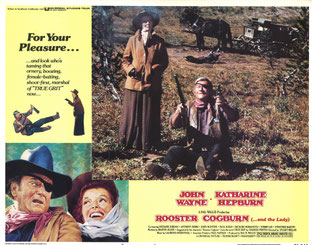John Wayne in Oregon

The True Grit sequel Rooster Cogburn was in production in Oregon from September 5 to October 30, 1974. John Wayne and Katharine Hepburn began their first collaborative film in the town of Bend, which has seen the production of many westerns over the years, such as The Indian Fighter and The Way West. West of town, in the Deschutes County, the Rooster Cogburn company shot all the mountain scenes. During the Bend location, cast and crew stayed in the town named Sunriver .

The Ryan Ranch Meadow was the scenic backdrop for "Fort Ruby". Here comes Rooster, portrayed by John Wayne, arriving after the Hawk gang raided the settlement.

The John Wayne location Ryan Ranch Meadow in the Deschutes National Forest as it is today, unchanged for 50 years. The wetland just south of Dillon Falls is on public land.

This beautiful vista of Mount Bachelor is seen in the credits of the John Wayne's second to last film Rooster Cogburn. It was actually shot at...

...at Sparks Lake, also in the National Forest near the crest of the central Cascade Range. This photograph was taken 50 years after the Rooster Cogburn shoot. Note the tree. As this was a 2nd unit shot and the riders were seen from a distance in silhouette, it is safe to say that John Wayne is not seen in the actual shot.

In the scene with John Wayne and Katharine Hepburn, Rooster Cogburn reveals that his real name is Reuben. Notice the large volcano rocks. The Cascades are primarily composed of volcanic igneous rock.

Several Rooster Cogburn scenes involving the nitro wagon where shot right outside Bend, Oregon, in Shevlin Park (because the company was able to move the wagon on paved roads that lead through the park). The movie company left one reminder behind: a marker on this fishing lodge in the park informs that they movie makers, in lieu of paying the filming fees for utilizing Shevlin Park, paid for the restoration of this cottage.

Smith Rock State Park in Terrebonne was mainly reserved for the bad guys's scenes in John Wayne's Rooster Cogburn. The setting for a western town with saloon scene was erected at the park entrance...

...exactly here. It's actually the first campground before you enter Smith Rock State Park. More than two decades after the shooting of John Wayne's Rooster Cogburn, Kevin Costner's "The Postman" made use of the scenic views of deep river canyons and stark rock formations.

This is the scene in Rooster Cogburn when Paul Koslo and the bunch arrive at Smith Rock State Park...

...shot right here: that's another angle from the campground, right at the entrance to Smith Rock State Park.

The location of Anthony Zerbe's knife fight on the wagon in the John Wayne movie Rooster Cogburn: the River Trail along the Crooked River at Smith Rock State Park.

Note the distinctive form of the little rock in the middle of the picture - you will recognize it in the Rooster Cogburn knife fight. Smith Rock is a world renowned rock-climbing destination, known as the birthplace of American sport climbing. Its locations where also used for the western The Way West, directed by John Wayne's long time collaborator Andrew V. McLaglen.

Rooster Cogburn and the Lady shoot the rapids: this exciting sequence, combining daring stunt work with excellent insert shots of John Wayne and Katharine Hepburn, was shot at...

...Benham Falls, the rapids of the Deschutes River located between Sunriver and Bend, Oregon. With a pitch of 22.5°, they are rated Class 5 for watercraft, and are the largest falls on the upper Deschutes.
Use the Benham West trailhead and you'll find out why the movie company used this river: they were able to easily place the camera along the path to shoot up and down the rapids.
If you follow the trail all the way to the top, you'll get to the pleateau where Kirk Douglas had the cavalry fort constructed for The Indian Fighter, subsequently known as Fort Benham.

While the whitewater rapids were shot on the Deschutes River, for the calmer river scenes the Rooster Cogburn movie company moved to the Rogue River in the Josephine and Curry counties, west of Grants Pass, Oregon.

A mural painting of a stagecoach painted on the side of a brick building in Grants Pass, Oregon. Note that the passenger has a certain resemblance with an outlaw called The Ringo Kid.

After the location work on Rooster Cogburn, John Wayne returned to Grant's Pass and Oregon once more. When Great Western Savings gave him editorial control over their commercials, the Duke choose to shoot the first one on the ranch of his friend Chick Iverson, at Grants Pass. It was filmed on October 25, 1977.
©All text content on this website is protected by copyright and other intellectual property laws. No part may be reproduced without the prior written permission. All photos courtesy of Roland Schaefli, unless otherwise stated.
This website is in no way associated with the John Wayne Estate or business enterprises. Go to johnwayne.com to find the official website and to https://johnwayne.org/ to read about the wonderful John Wayne Cancer Foundation.
more john wayne locations to scout
If you like this site, you'll like the book: the first comprehensive guide to the John Wayne Locations, with hundreds of then-and-now photos, unpublished behind-the-scenes-pictures and detailed tour descriptions
Tracking John Wayne: The complete Tourguide
Find directions to locations and anecdotes from the Duke's movie sets in this new publication from McFarland, available at bookstores and online shops
For all locations mentioned on this website, the book offers behind-the-scenes stories, making-of anecdotes and never before published photos

